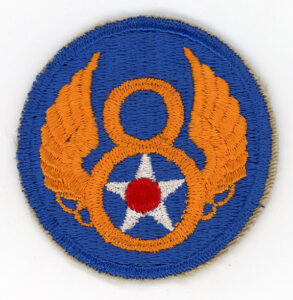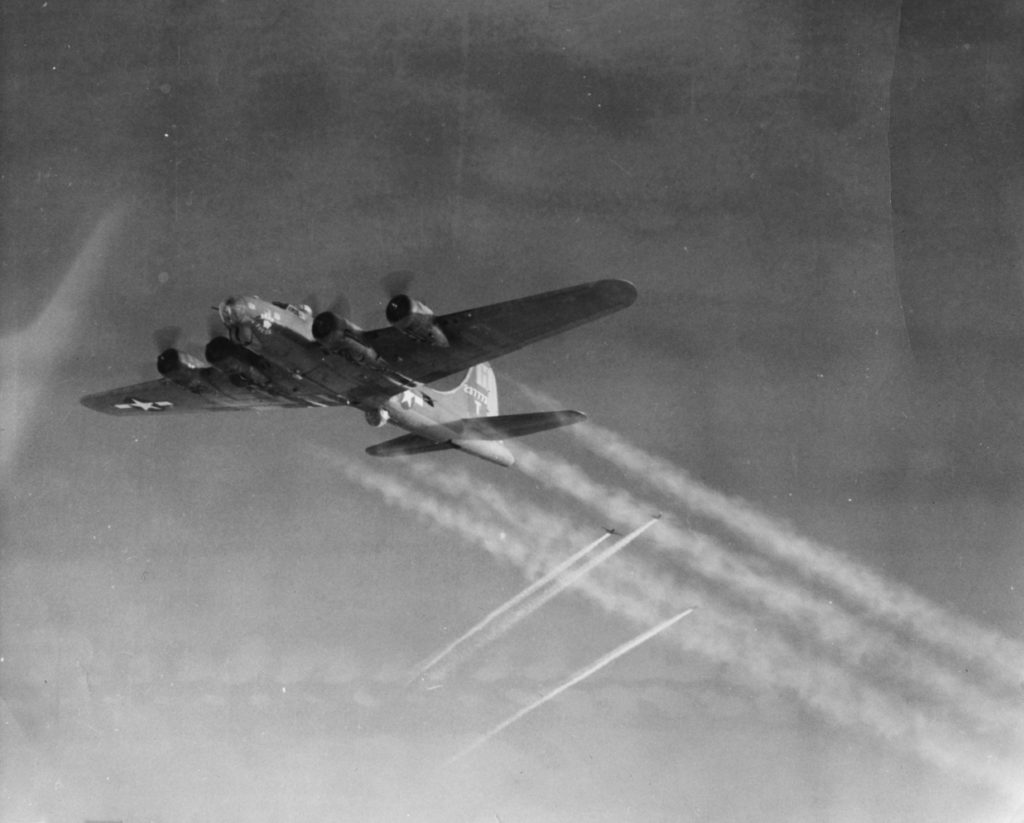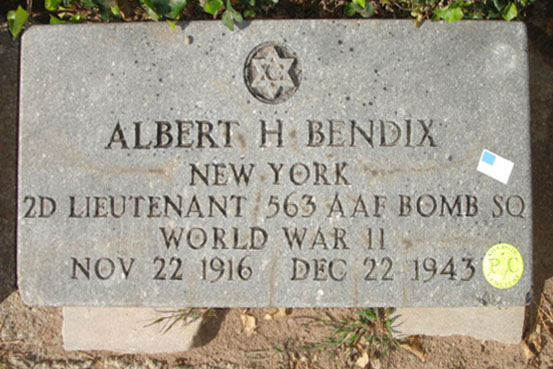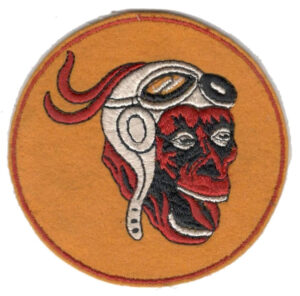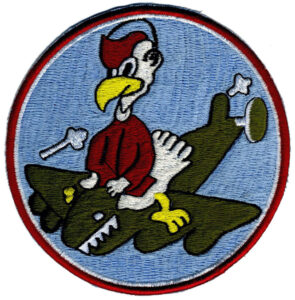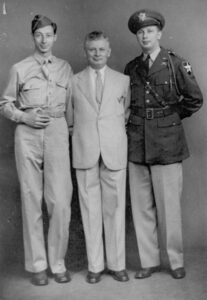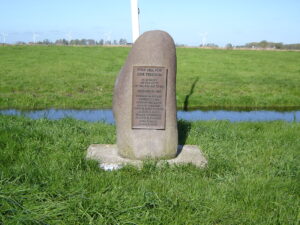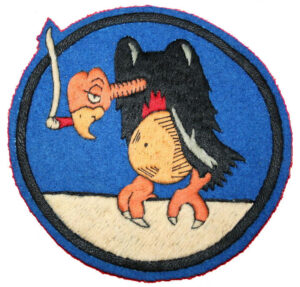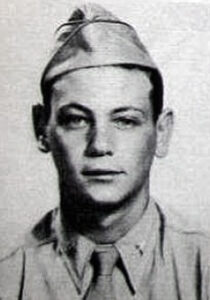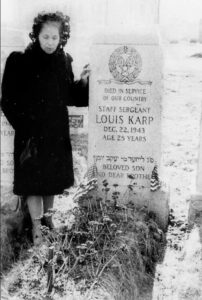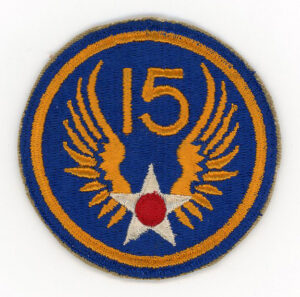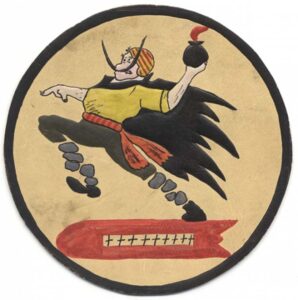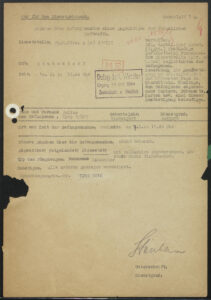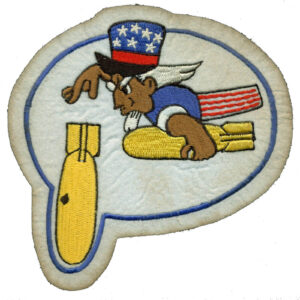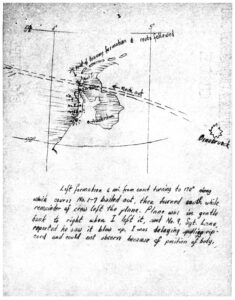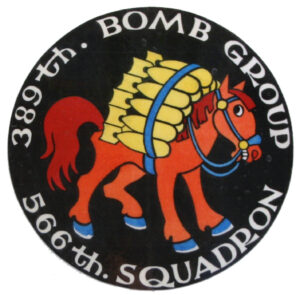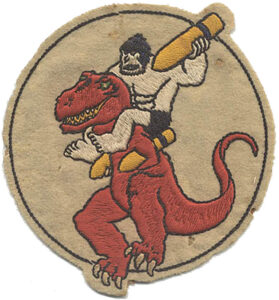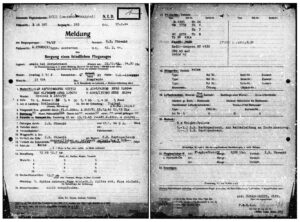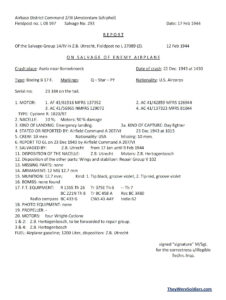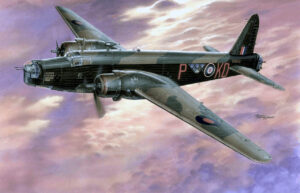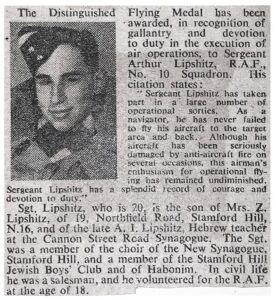[Here’s a new version of an old post – “old” that is, at least by Internet standards. It’s really, really (did I say really?!) long, like the majority of my posts. Well, in this world of 2022, somebody’s gotta’ write at length. I guess that person is me…]
As part of my ongoing series of posts about Jewish WW II servicemen who appeared in The New York Times – whether as military casualties, awards recipients, or as subjects of general news items – “this” post, originally created in August of 2017 and focusing on 2 Lt. Albert Hunt Bendix of the United States Army Air Force – has now been expanded and corrected. It now more broadly reflects the service of Jewish airmen and soldiers who were military casualties December 22, 1943, the late December Wednesday when Lt. Bendix did not return from a combat mission to Germany. For those men who were members of the United States Army Air Force, the post now includes – where available – images of the emblems of the squadrons to which they were assigned.
So first, to start with Lt. Bendix himself…
From the Upper West Side of Manhattan, Lieutenant Bendix (0-683894) was the navigator of a B-17 Flying Fortress, and lost his life during a mission to the city of Munster. Reported Missing in Action in a Casualty List published on February 8, 1944, his brief obituary, transcribed below, appeared in the Times on September 21, 1945.
Albert’s parents were Harry Hunt and Olga (Coyne) Bendix; his sisters and brother Mrs. Annette Mack, Mrs. Maxine Bloom, and Harry, Jr. According to biographical information at FindAGrave.com, his grandfather Theodore Bendix, “…was musical director of “The Spring Maid” with Mizzi [actually, “Mitzi”] Hajos.”
__________
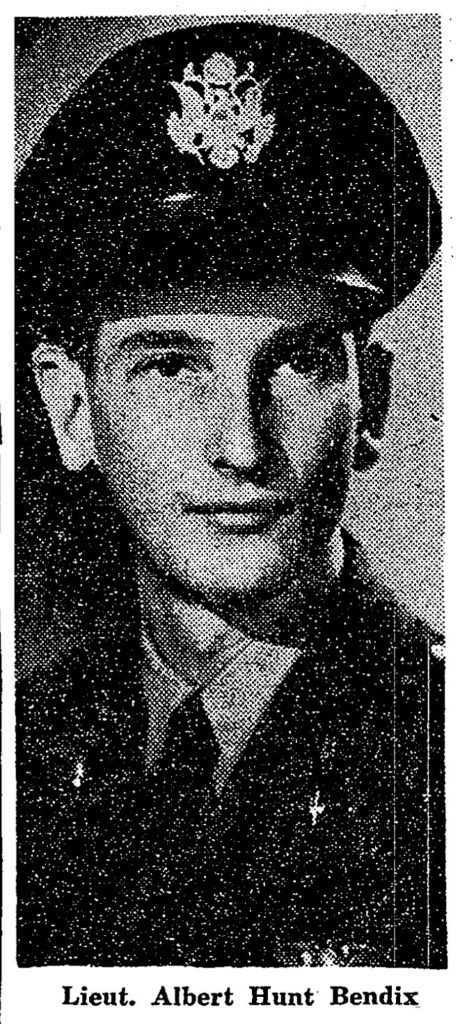 Lieut. Albert Hunt Bendix, son of Mr. and Mrs. Harry Bendix of 140 Riverside Drive, navigator of a B-17 in the Eighth Air Force and winner of the Air Medal, who was listed as missing in action Jan. 10, 1944, has been reported officially dead. He was 26 years old.
Lieut. Albert Hunt Bendix, son of Mr. and Mrs. Harry Bendix of 140 Riverside Drive, navigator of a B-17 in the Eighth Air Force and winner of the Air Medal, who was listed as missing in action Jan. 10, 1944, has been reported officially dead. He was 26 years old.
Lieutenant Bendix was shot down over Muenster, Germany, on his eighth mission on Dec. 22, 1943. He had been associated with an insurance brokerage concern in this city. He entered the Army in 1940.
__________
Here’s the location of the Bendix family’s residence: 140 Riverside Drive in Manhattan, an image originally from (and no longer at!) RealtyHop.com.
__________
Albert was a crew member aboard B-17G 42-37773, of the 563rd Bomb Squadron, 388th Bomb Group, 8th Air Force, piloted by 2 Lt. Webster Merriam Bull (0-745609; from Omaha, Ne.).
42-37773, nicknamed Full House, last seen with its #1 engine feathered, crashed into the Ijsselmeer, near Edam, Holland, shortly after the 388th’s formation had dropped its bombs and was enroute back to England.
Of the plane’s ten crewmen, two survived: They were left waist gunner S/Sgt. John F. Rogowski (32381701; left waist gunner, from Buffalo, N.Y.), and tail gunner S/Sgt. Thomas Glenn Wesson, Jr. (14182114; tail gunner, from Florence, Al.), both of whom parachuted just before the aircraft crashed at sea. Captured, they spent the remainder of the war as POWs at Stalag 17B Braunau Gneikendorf, near Krems Austria. The bomber’s other eight crewmen parachuted at too low an altitude, or, succumbed to the coldness of the December sea.
As reported in Missing Air Crew Report 3148, “Lt. Bull’s wing man report[s] that he dropped slowly behind the formation about 5 to 10 minutes after bombs away on the return route. One of the men dropped back with him a considerable distance behind the group. Bull feathered his #1 engine and called to his wing man over the radio, telling him to rejoin the formation, as he would be unable to do so. Bull’s A/C was last seen somewhere over Holland. Going down into the overcast under control and escorted by 4 P-47s.”
Besides Lt. Bendix and Bull, and Sergeants Rogowski and Wesson, Full House’s crew included:
Hobbs, Leavitt Patrick, 2 Lt., 0-680636 – Co-Pilot – (San Rafael, Ca.) – KIA
Gunderson, Loran Arthur, 2 Lt., 0-744274 – Bombardier – (Chicago, Il.) – KIA
Pasque, Angelo, T/Sgt., 39165858 – Flight Engineer – (Los Angeles, Ca.) – KIA
Riley, Howard William, T/Sgt., 16150364 – Radio Operator – (Detroit, Mi.) – KIA
Rush, Chester Noah, Sgt., 39250775 – Gunner (Ball Turret) – (St. Louis, Mo.) – KIA
Marsilio, Rudolph Ceaser, S/Sgt., 13126890 – Gunner (Right Waist) – (Philadelphia, Pa.) – KIA
__________
This excellent in-flight photo of Full House, from the American Air Museum in Britain website, was taken on December 20, 1943, two days before the plane’s loss…
…while this image, showing the bomber flying through flak bursts, is from the 388th Bomb Group Database.
__________
Born on November 22, 1916, Albert was buried – at Block I, Section 28, Plot 197, Grave 2 – at Riverside Cemetery, in Saddle Brook, New Jersey, on May 13, 1949. His name is listed on page 273 of Volume II of American Jews in World War II. His matzeva, photographed by FindAGrave contributor dalya d, is shown below:
Full information about the loss of Full House and its crew can be found in this remarkably detailed account at the ZZAirwar (Zuyder Zee Air War) website.
____________________
Other Jewish military casualties on December 22, 1943 (25 Kislev 5704) are listed below.
For those who lost their lives on this date…
– .ת.נ.צ.ב.ה. –
…Tehé Nafshó Tzrurá Bitzrór Haḥayím
May his soul be bound up in the bond of everlasting life.
__________
306th Bomb Group, 367th Bomb Squadron
Sall, Henry, S/Sgt., 32177039, Gunner (Right Waist), Air Medal, 2 Oak Leaf Clusters, Purple Heart, 17 missions
Mr. Andrew Sall (brother), 535 Graham Ave., Brooklyn, N.Y.
MACR 1716; B-17F, 42-3363 (“GY * G”, “Punchy”); Pilot – 1 Lt. James E. Winter; 10 crewmen – 3 survivors; Luftgaukommando Report KU 547
Netherlands American Cemetery, Margraten, Netherlands – Plot P, Row 20, Grave 1
Casualty Lists 1/23/44, 8/24/44
American Jews in World War II – 425
Though believed to have been shot down by German fighters, there are no specific eyewitness statement about Punchy’s loss in MACR 1716. However, the report lists the aircraft as having been last sighted by Second Lieutenants John J. Stolz and Charles O. Smith, and, First Lieutenant Martin Newstreet.
Of the plane’s ten crew members, there were three survivors:
2 Lt. Robert F. Jones – Navigator
T/Sgt. David M. Hovis – Flight Engineer
S/Sgt. Otis F. Thomas – Tail Gunner
According to Lt. Jones, Lt. Winter was last seen, “At the controls of the plane.” He was believed to have been attempting, “…to get the plane under control so the other crew members could bail out.” “The interphone system was knocked out by [a] flak burst in nose of plane about 5 min. before we were finished off by fighter planes. All casualties either dead, or, wounded and unable to escape by parachute.”
__________
445th Bomb Group, 701st Bomb Squadron
Silverman, Conrad, 2 Lt., 0-685748, Navigator, Purple Heart
Brooklyn, N.Y. – 12/18/15
Mr. and Mrs. Tobias and Fannie Silverman (parents), Beatrice, Estelle, and Leo Silverman (sisters and brother), 1060 52nd St., Brooklyn, N.Y.
MACR 16098; B-24H 42-7520 (not 42-64438!), “Snow Goose”; Pilot – 2 Lt. Norman H. Nelson; 10 crewmen – no survivors; Luftgaukommando Report AV 447/44
Crashed near Bolsward, Netherlands
Zachary Taylor National Cemetery, Louisville, Ky. – Section E 101
Brooklyn Eagle 7/25/43, 2/26/44
Casualty Lists 1/23/44, 2/27/44
American Jews in World War II – 444
Two months after the loss of Snow Goose, the following article about Lt. Silverman appeared in the Brooklyn Eagle.
Won’t Accept Death Of Brother in Nazi Raid
February 26, 1944
Sister of Lt. Silverman, an Army Nurse Overseas, Searching for Further Details
Beatrice Silverman, sister of Lt. Conrad Silverman, officially listed as killed in a raid over Germany, refuses to take news of his death as final and is conducting a personal investigation for further details. She is a lieutenant in the army nursing corps and stationed overseas.
Silverman is 27. He was in the infantry first and later transferred to the air corps as a navigator. He was shipped across in November, 1943.
Two other members of her family are in the armed forces – Estelle, a navy nurse, and Leo, a major in the army. Conrad attended New Utrecht High School and Brooklyn College. The family lives at 1060 52nd St.
Postwar “fill-in” Missing Air Crew Report 16098, which incorrectly denotes the serial number of Snow Goose as 42-64438, carries only the cryptic statement, “Ship #438 [sic] attacked by fighters at time of bombs away. It was last seen going down out of control and no chutes were observed.”
In 2008, a monument in memory of Snow Goose’s crew was erected at the bomber’s crash site, seen in this flickr photostream image of Edwin van Bloois. As mentioned by Mr. van Bloois and unknown to the Army Air Force in December of 1943, “Above Friesland, the B-24 was attacked by a German night fighter and in the dramatic fire fight that followed the crew tried desperately to shoot down its belligerent. The crew tried to land the plane but crashed near Bolsward. The bombs were not dropped before the landing and exploded during the crash.”
In early May of 2013 (nineteen years ago already?!…), two nieces of Lt. Nelson paid homage to their uncle at the bomber’s crash site, in an event – seen in the video below – reported upon by GPTV. While the video is unaccompanied by English-language translation (oh, well…), the caption, translated via OogleTranslate, is as follows, “In many places, 2 minutes of silence was observed on Saturday evening at a war memorial. One such monument commemorates the crash of the B-24 bomber Snow Goose in Bolsward. The monument was placed in 2008. Ten young men were killed in the crash. On Saturday a number of relatives of one of the fallen crew members came to Bolsward. Two nieces of Norman Nelson. Joanne Nelson and Lynda Brown-Nelson.”
Additional information about the December 22 mission and Snow Goose can be found at the websites of the 445th Bomb Group, and, Teunis Schuurman.
__________
446th Bomb Group, 704th Bomb Squadron
Jacobson, Sydney Charles, 2 Lt., 0-742719, Pilot (Bomber), Purple Heart, 2 Missions
Mrs. Eleanor A. Jacobson (wife), 1777 Somerset St., Providence, R.I.
MACR 2008; B-24H 42-7613 (“FL * H”, “Mi Akin Ass”); 10 crewmen – 7 survivors
Zachary Taylor National Cemetery, Louisville, Ky. – Section F 29
American Jews in World War II – 562
Akin to the Snow Goose, the Missing Air Crew Report for Mi Akin Ass is entirely vague about what actually happened to the bomber, for which there are no eyewitness accounts, other than the generic statement, “Information not available, undoubtedly due to enemy action. Aircraft last seen apparently under control entering overcast.”
What is present in the MACR are co-pilot 1 Lt. Robert Dale Bingham’s postwar comments about the fate of the three crewmen who did not survive the mission: Lt. Jacobson, Bombardier 2 Lt. Wade H. Krauss, and Flight Engineer S/Sgt. Orley E. Kjelgren, who are buried in common grave F-29 at Zachary Taylor National Cemetery. Lt. Bingham’s comments follow. While certainly informative about the fate of all three men, when it comes to Lt. Jacobson, they reveal something else about Robert D. Bingham, and that with immediate clarity.
Circumstances of bail out of crew members for whom no individual questionnaire is attached: No knowledge other than that none jumped the bail out signal, all was regular. I just didn’t happen to actually see a crew member jump.
What members of crew were in the aircraft when it struck the ground? Have no positive knowledge but believe 2nd Lt. Wade H. Krauss and Kjelgren, Orley E. S/Sgt.
Bombardier Krauss:
Any hearsay information: He did not fire a shot at attacking aircraft, he had turret turned to one side & did not move it or himself when Lt. Cranford attempted to get him to bail out by pounding on turret glass to attract his attention.
Flight Engineer Kjelgren:
Any hearsay information: Lt. Cranford claims to have seen a leg through trap door calculated to have been Kjelgren, Orley E., from position last seen in.
Pilot Jacobson:
Did he bail out: Uncertain.
Last contact or conversation just prior to or at time of loss of plane: I told of and pointed to fire in bomb bay.
Was he injured: Not at last contact with him.
Where was he last seen: Stepping out onto flight deck.
Any hearsay information: The radio operator, S/Sgt. Mahan told me on ground that S.C. Jacobson stepped out on flight deck & attempted to put on parachute but that it opened & was in his arms. Later Sgt. Evans (tail gunner) told me that he was seen to attempt a jump only to have chute catch on plane.
Any explanation of his fate based in part of wholly on supposition: I believe the above to be true as he did leave the controls without warning and take to the flight deck in a big rush as if to be in a hurry to get out. He was a smart boy & a Jew, it seems to fit.”
Well now. What Robert Bingham really suggested was that Lt. Jacobson’s actions in attempting to abandon his aircraft were not the actions of Lt. Sydney C. Jacobson the man, but instead “a Jew” named Sydney Jacobson, for whom Bingham’s use of the word “smart” is far more indictment than compliment. In a larger sense, while an attitude of comradeship and solidarity was not at all uncommon among Army Air Force air crews (many, many accounts in Missing Air Crew Reports attest to this, often in riveting, dramatic, and tragic detail), this was not universally so. Yet, having reviewed all the Missing Air Crew Reports, I can state that comments such as Bingham’s are extraordinarily few in number.
One of the seven survivors of Mi Akin Ass was the plane’s left waist gunner, Sergeant Sidney H. Raiken (16155375), the son of Harry (1/3/82-1/31/58) and Fanny (Robin) Raiken, and brother of Florence, who hailed from 2718 North 40th Street, in Milwaukee. Captured, he spent the remainder of the war at Stalag Luft 4. His name appeared in a list of liberated POWs released by the War Department on June 6, 1945, and in 1947, on page 585 of American Jews in World War II, wherein it’s indicated that he was awarded the Purple Heart. The absence of his receipt of the Air Medal (and Oak Leaf Clusters for that medal) suggests that he flew less than five combat missions.
Sidney Raiken’s account of his final mission – below – is excerpted from Evelyn R. Lewis’ book The War Stories of Sidney H. Raiken. Two discrepancies are present in his account. Note that he mentions, “the ball turret gunner to the left of me,” and, words to the effect that he (himself?!) had to shut down one of the plane’s engines. Given his crew position as left waist gunner, the “ball gunner” referred to was almost certainly the right waist gunner (S/Sgt. Joseph P. McDonald), the ball turret gunner – not directly visible from the waist gun position – having been S/Sgt. Scott F. Swinburn. Shutting down one of the bomber’s engines probably refers to an action taken by Lieutenants Jacobson or Bingham.
Flying along and this ball gunner on the left of me, I didn’t even know him, but flying along, it was cold, I looked at him. He had ice on the eyelashes. Periodically, we would cock the gun because of the cold [to] be sure it’s working so it wouldn’t freeze up. So it was difficult to do. You didn’t have much to brace on, and your oxygen hose went down your chest here. So this guy next to me, he couldn’t cock his gun so he had to have a brace against his chest. So what he does is disconnect his oxygen mask, which is the worst thing you could do. So it was just lucky that I turned around that instant because here he is, slumped over the gun, no oxygen, 25,000 feet. So what I did was I gave him a… I put on his oxygen hose again, connected it, and gave him a pure shot of oxygen which we could do. And he came to, but another minute he would have been gone.
We’re in formation coming back and the wing is starting to vibrate pretty badly, so I had to shut off one engine. And a couple minutes later another, the wing started vibrating again. I had to shut off another engine. So we’re operating on two engines so we start drifting back from the formation and we were no more than 100 yards from formation when a black night fighter, Me 110 was on my side with the wing up and right in front of me here’s this black wing with the German crosses on and I told the ball gunner, I says, “Well why didn’t you tell me he was coming? I could have taken a shot at him and he says, “I was just too scared.”
That was our first time we were under fire attack. So here the fighters are coming in, so the pilot would call out. He’d say, “Three coming in at 11 o’clock out of the sun.” And you’d turn your body so it would be toward 11 o’clock to give the least amount of area. And they kept coming in and I noticed the plane started burning and the pilot was kind of trying to hit the cloud cover almost in a dive. And I couldn’t get at the fire because it was pretty hard to get to and started burning there and I guess the bomb bay must have been all aflame too and I don’t know just what happened but the thing was burning to the extent and I didn’t hear any orders to leave so we scrambled to the rear hatch and just left; the ball gunner and I left. We found out that the plane exploded just a couple minutes after that so the ball gunner, like I said before, was above me as we drifted down. You got that story.
Right after that first Me 110 made a pass at us, subsequent passes of these fighters, I noticed my gloves were all ripped apart. I had the thumbs on the gun and the first thing I knew my gloves were in shreds, both of them. I couldn’t feel anything. I didn’t know what was going on and I didn’t realize that my two hands were wounded and, of course, it dawned on me after I bailed out that not only was my hands wounded, but my bone was sticking out of the one hand.
And it was a lucky thing I didn’t put on that flack jacket. We had a bullet proof vest that weighed a ton, it was made out of layers of steel and had I put that on I would have been a dead man because not only were my hands wounded but my leather jacket was all kinds of ripped apart, the flaps were gone, things like that. Found out later that they were shooting 20mm shells that exploded inside the airplane, like a grenade and I was just lucky it was just my finger. I wasn’t blinded or killed, something like that. If I wore a bullet proof vest, instead of knocking the flaps off my leather jacket and all that, it would have went inside the vest. The vest just protected you in the front and the rear but not on the side, so the shot would have gone inside the vest, but that thing weighed a ton, we didn’t wear them.
Going out the lower hatch, the ball gunner is out of the bubble on the bottom and they are leaving. The lower hatch opens easily. We go out. Nothing is happening. I am tugging at the handle and nothing is happening and then it dawns on me that I am pulling the wrong handle. I don’t know how far I fell freefall and I pulled the red handle. It was the red handle that opened, and I start drifting down and at that point I saw the ball gunner was above me. …
Sidney Raiken passed away on December 1, 2002, and is buried at Mount Sinai Memorial Park, Los Angeles, Ca.
__________
448th Bomb Group, 714th Bomb Squadron
There were no survivors from the 11 crew members of B-24H 42-52105, an apparently un-nicknamed Liberator piloted by 2 Lt. David E. Manning. The crew included 2 Lt. Jerome Slepin, the bomber’s navigator, and S/Sgt. Irving Mazur, its left waist gunner.
Unlike other bomber losses on December 22, 1943, an eyewitness account does exist pertaining to this plane’s loss. As stated in MACR 3313 by First Lieutenant Karl M. Schlund, pilot of nearby B-24H 42-7683 (“Sweet Sioux“), “I was flying the #2 position in a three ship element of which Lt. Manning was in the #3 position which Lt. Hughey was leading. Over the target area which was Osnabruck, Germany Lt. Manning’s ship was seen going thru heavy flak. A minute or so later his ship left the formation and was last seen going thru the cloud cover with enemy fighters attacking his ship as it went down. The ship appeared to be under control. No chutes were seen leaving the ship.” The events pertaining to the bomber’s loss are diagrammed at zzairwar.
Only five members of the bomber’s crew were ever found, and thus, have places of burial. Along with Lt. Slepin, these men were:
2 Lt. Robert F. Palicki (Co-Pilot)
2 Lt. Arne O. Bergrum (Bombardier)
2 Lt. Byron E. Lanphear (Observer)
Sgt. William S. Pennypacker (Right Waist Gunner)
This plane’s loss is covered in Luftgaukommando Report AV 879/44 (which specifically pertains to Lt. Slepin), and, reports U 2611, U 2658, and U 2742.
Lt. Slepin’s parents were William (2/7/93-2/20/76) and Eva (Rosenberg) Slepin (12/2/96-7/26/57), and his family, including brothers Louis and Richard, resided at 929 Park Avenue in New York City. His father was in some way – what way, I don’t know – associated with the Trutex Dress Company at 1385 Broadway in Manhattan. His name having appeared in casualty lists issued by the War Department on January 23, 1944 (Missing in Action), and September 19, 1944 (confirmed Killed in Action), he is buried at the Netherlands American Cemetery, in Margraten, Holland, at Plot B, Row 18, Grave 18. His name can be found on page 447 of American Jews in World War II, where his sole award is listed as the Purple Heart. He was born in 1922.
S/Sgt. Mazur was another New Yorker, albeit a Brooklyn type of New Yorker. His father was Samuel A. Mazur, who resided at 2000 84th Street, and his brother was Sidney, who lived at 206 Quenton Road. Born in 1921, his name appeared in the same January 23, 1944, casualty list as that of Lt. Slepin, and on page 390 of American Jews in World War II, where he is listed as having been awarded the Air Medal and Purple Heart, suggesting that he had completed between 5 and 10 combat missions. His name is commemorated at the Tablets of the Missing at Netherlands American Cemetery, at Margraten, Holland.
__________
Killed (Non-Battle)
En Route to European or Mediterranean Theater of War
As shown in many of my prior blog posts, and especially as revealed in literature about WW II military aviation, whether online, at (for example) Aviation Archeology, or in printed format, in the form of Anthony J. Mireles magisterial three-volume work Fatal Army Air Forces Aviation Accidents in the United States, 1941-1945, a tremendous number of Second World War United States aircraft and personnel losses occurred within and near the continental United States during activity neither directly nor immediately associated with contact with the enemy. (I’m sure something analogous could be said for the air forces of other nations that took part in the war, though other than for RAF Bomber Command, I don’t know how well, of if, this has been documented.)
One such incident occurred near West Palm Beach, Florida, on December 22, 1943, and involved the loss of a B-24 Liberator departing on a ferry mission to Europe. Piloted by 2 Lt. Samuel G. Dean, the bomber, carrying 14 crew and passengers, crashed 3 miles northwest of Morrison Army Airfield shortly after taking off. As described by Anthony Mireles in Volume I (page 622) of Fatal Army Air Forces Aviation Accidents in the United States, “The airplane was taking off [0200 hours] on a ferry mission to the European War Theater when it collided with treetops about three-quarters of a mile from the end of the northwest runway. The collision apparently caused the failure of at least two engines, the pieces of which were found near the trees. The airplane climbed slightly after the initial impact and, losing power, veered to the left and crashed about three miles from the end of the northwest runway. The B-24 crashed into swampy terrain … Lt. Cáceres [2 Lt. Radames E. Cáceres] and S/Sgt. [Howard G.] Sewell were found alive in the wreckage. Lt. Cáceres died at 1930 EWT. S/Sgt. Sewell died on 12/23/43 at 1350 EWT.”
Eliot Kleinberg’s story of the bomber’s loss, accompanied by illustrations, and, biographical profiles of the plane’s crew and passengers, appeared in the Palm Beach Post on May 25, 2014 (since updated on May 26, 2022), under the title “The Forgotten 14: A Story Never Told“. As of September, 2022, his story is still – fortunately! – accessible online.
Among the bomber’s crew was aerial gunner S/Sgt. Louis Karp (Leezer bar Yakov Yosef) (32629703) from the Bronx. Born in Manhattan on September 14, 1918, he was the son of Jacob and Jennie Karp, his family residing at 1343 Findley Avenue. Buried at Mount Lebanon Cemetery, Glendale, N.Y. (Society Workmen’s Circle, Block WC, Section 5, Line 27, Grave 7), his name appears on page 357 of American Jews in World War Two, with a simple notation indicating that he lost his life in a non-combat event.
“Louis Karp in West Palm Beach in December, 1943” (Karp Family Photo, from “The Forgotten 14”)
“In an undated photograph believed to be from the 1940s, Louis Karp’s mother Jennie makes one of her nearly weekly visits to his grave in New York. When Louis died, she had two other sons in the war. When another was shot down and believed killed, she asked the President to bring the other home.” (Karp Family Photo, from “The Forgotten 14”)
This 2017 image of Sgt. Karp’s matzeva is by FindAGrave contributor S. Daino.
____________________
United States Army Air Force, 15th Air Force
“The only information I gave them was my name, rank and serial number.”
And, a related story…
Louis had five siblings – Edith, Julius, Maurice, Milton, and Morris – his four brothers all serving in the military, though “The Forgotten 14” states that Morris, then in Europe, was returned from there to complete his military service in the continental United States. However, Julius an aerial gunner like his brother, left the United States for Europe on December 25, 1943 (ironically departing from Morrison Field), and was assigned to the 2nd Bomb Group, a B-17-equipped bombardment group of the 15th Air Force.
Julius wrote an account of his military service entitled (well, pretty appropriately!) The Julius Karp Story, which gives a substantive overview of his military experiences, and very briefly touches his pre-war and post-war life.
Initially assigned to the 2nd Bomb Group’s 20th Bomb Squadron…
…Julius was wounded on February 24, 1944 – during “Big Week” – and was awarded the Silver Star for his actions that day. His award citation reads: “For gallantry in action while participating as Right Waist Gunner on a B-17 type aircraft during a bombing mission against an important enemy aircraft factory at Styer, Austria, on 24 February 1944, his formation was intercepted and heavily attacked by approximately 150 enemy fighters. In the ensuing engagement the aircraft was severely damaged and Sergeant Karp received a serious and painful wound in the left leg from the enemy plane cannon fire. Despite the pain and shock he continued to man his guns in gallant defense of his plane and crew, beating off successive attacks until he lost consciousness from loss of blood and lack of oxygen. By his conspicuous courage and unselfishness in his determination to carry out his mission regardless of all hazards together with his gallantry and devotion to duty in the fulfillment of his personal responsibility, Sergeant Karp has distinguished himself and the Armed Forces of the United States of America.”
On a date unknown during his service in the 2nd Bomb Group, Julius was apparently transferred to the Group’s 49th Bomb Squadron…
…which may – or may not? – have been related to the following incident: “…if you were Jewish in the service at that time, you had to sort of keep to yourself because there was anti-Semitism among the Americans at times too. One pilot I flew with did something wrong on the flight and I told him so. I was the flight engineer. When we got back, he called me a “damned Jew”. I went to my commanding officer and told him about this and I refused to fly with them again. He agreed and grounded me for a few days and then put me with another crew. The next day, the crew that I had flown with was shot down.”
In any event, Julius Karp was shot down on his 48th mission.
This occurred during a bombardment mission to Blechhammer South, Germany, on August 7, 1944. Flying in a B-17G piloted by 1 Lt. Dwight F. Hastings, his aircraft was struck by anti-aircraft fire. The entire crew parachuted east of and over the target, Lt. Hastings last of all. According to navigator 2 Lt. James A. Shaw, “[Hastings] was last man to leave and believe he should receive commendation the way he stuck to the controls up to the last.” The loss of this un-nicknamed aircraft, 44-6176, is covered in Missing Air Crew Report 7470 and Luftgaukommando Report KSU / ME 1890.
Nine of the bomber’s ten crew members survived. Ball turret gunner S/Sgt. Howard J. Kidney was definitely uninjured when he left the aircraft, but did not survive, other crewmen (in 1946, at least) being uncertain of his actual fate. Lt. Shaw reported having been told by a German guard at Mechnitz, that Kidney was shot while descending in his parachute, or (as related to him by the radio operator and left waist gunner), that Kidney may have been killed during an escape attempt with Russian POWs. The former is the most likely eventuality, as the pertinent Luftgaukommando Report includes the (deliberately?) ambiguous statement that the Sergeant “met his death by being shot down in an air attack”, thus, intentionally not specifying how he died.
A notable aspect of Sgt. Karp’s memoir concerns his capture and interrogation, specifically in terms of both his refusal to answer his captors’ questions, and, in reference to his identity as a Jew. As stated in his essay, “We were searched and locked up until some SS troopers arrived to question us. The only food they gave us was some black bread and water. I was there for three days when I was taken to a railroad yard and put in a pig box car and shipped to Frankfurt for more questioning by SS troopers. They asked me again and again where we were flying and what our mission was. The only information I gave them was my name, rank and serial number. They got angry and made me get undressed and put me in another room. They poured ice water on me. After a while they told me to get dressed and I was taken again to another room. The guard looked at my dog tag and asked me what religion I was. I had an H on my dog tags for Hebrew, but I smashed the H with pliers before I went over seas. I had heard rumors that they were killing Jews. I told them I was Protestant.”
Well… There is a difference between what Julius recorded and what has been preserved. As seen in this image of Julius’ dog-tag, one of the items within Luftgaukommando Report KSU / ME 1890 (accessed via the National Archives) the dog-tag, obviously bearing an “H” for Hebrew, is intact and undamaged, appearing much the same as it did when worn nearly eight decades ago.
However, the “Angaben über Gefangennahme eines Angehörigen der feidnlichen Luftwaffe” – the “Report of the Capture of Enemy Air Force Personnel” in KSU / ME 1890 – does corroborate at least part of Julius’ account of his interrogation.
This full translation of the report (note that it was completed on August 10, three days after Julius’ capture) reveals that Julius refused to give his date of birth, and similarly, “To all other questions Prisoner of War refused to make any statement.”
This photo, from mid-summer of 1945, shows a pensive Julius with his sister Edith (the only girl in the family?), and mother Jennie at Louis’ grave, shortly after Julius’ return to the United States.
Born in Manhattan on June 11, 1922, Julius passed away on February 9, 2011. The photo below, from 2006, accompanies his February 10, 2011 obituary in the Houston Chron News.
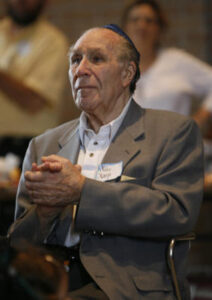
____________________
Prisoners of War
44th Bomb Group, 66th Bomb Squadron
Fleischman, Abel, S/Sgt., 32509819, Radio Operator, Air Medal, Purple Heart
POW at Stalag Luft 4 (Gross-Tychow) and Stalag Luft 1 (Barth)
Mr. William Fleischman (father), 1634 Sterling Place, Brooklyn, N.Y.
Born 3/5/21 – Died 9/23/98
MACR 1713; B-24H 42-7533; Pilot – 1 Lt. Warren W. Oakley; 10 crewmen – 3 survivors; Luftgaukommando Report KU 539
Casualty Lists 1/23/44 (Missing in Action), 4/21/44 (Prisoner of War), 6/8/45 (Liberated)
American Jews in World War II – 311
This account of the survival of S/Sgt. Fleischman, flight engineer T/Sgt. John F. Byers, and navigator 1 Lt. Frank D. Powers comes from Will Lundy’s 44th Bomb Group Roll of Honor and Casualties. As he reported in MACR 1713, six of the crew’s seven fatalities were entirely uninjured, but were unable to exit the falling aircraft because of the force of its final spin. Lt. Christian was able to escape from the plane, but his parachute malfunctioned.
The second 66th Squadron aircraft lost was piloted by 1st Lt. Warren W. Oakley and Richard K. Collins. The MACR contains this information: Aircraft #533 was reported as lagging in the rear of the formation just after target with bomb bay doors still open. Different crews observed this aircraft at various times between 1400 and 1431 hours and each one reported that it was losing altitude but apparently under control. Aircraft #548 (Heskett’s) had been flying on the right wing and Heskett reported that he pulled alongside #533 to determine why they were not keeping up with the formation. (It was later learned that #533 had lost three superchargers.) Oakley motioned for him to go ahead and catch the formation. At 1431, the tail gunner of #548, saw the ship begin to spiral down below into the clouds. It was not believed likely that any of the crew survived as no chutes were seen to open.
A crew member, Sgt. Abel Fleischman, tells his account: “I was flying spare radio operator on this crew. First of all, we were hit by flak, and then jumped by about five to seven fighters. We couldn’t unload our bombs as they were stuck as were the bomb bay doors. Our bombardier, Christian, asked the pilot if he should unload them by hand, but the pilot said, ‘No. We are over enemy-occupied land.’ “The fighters knocked all or at least part of our tail off. After Byers (engineer) came out of the top turret and bailed out, I think we started to go into a spin, but I managed to get out as well. Just Byers and I got out. [Editor’s note: One more crewmember, Lt. Frank Powers, also got out.] “Miller’s crew also went down the same day – that was my original crew with whom I trained. I landed by parachute in Holland (near Den Ham). After hiding out a couple of hours, was captured and taken to a Dutch hospital for about six weeks. Then to Frankfurt, Stalag Luft 6, 4, and l.”
Lt. Frank D. Powers, navigator, adds, “We were a squadron leader and made our target. But we lost two engines on the return, our wingmen abandoned us, and flak or fighters hit the tail surfaces – and we spiraled down, out of control. T/Sgt. Christian, the bombardier, and I had no warning of how serious the problem was, so we stayed with the plane. (Pilots were so busy trying to regain control they couldn’t ring the bail out warning.) We thought that Warren Oakley would regain control. Byers and the radio operator (Fleischman) knew about the tail damage and they abandoned ship at high altitude. Had Byers warned us, we probably all would have made it. Christian, bless him, helped me put on my parachute and was killed by the jump. We were so low, less than 800 feet at that time, that Christian’s chute never fully opened.
“Before the local policemen arrived, a young man of about 25 or so, came up to me and in good English, said ‘I congratulate you – all of your friends are dead.’ At that time I did not know we were in the Netherlands and had the fleeting thought that he was a German and was going to inflict a terrible beating on me.
“Then a policeman, a young man about my age, 22, arrived and his sympathy was with me, but with the surrounding families knowing that I was there, he had to phone the German authorities and release me to them.”
I contacted the widow of John F. Byers, who gave me the following information: “John told me much of what Abel Fleishman told you. He also thought that they were the only two to get out. John was too big to wear his chute in the turret, so he grabbed it and snapped it on, but when he tried to pull the ripcord, he had it on upside down. In his own words, it scared the hell out of him, but as you know, it worked. He landed in a plowed field somewhere in Holland, went in to the top of his boots, and hurt his knee. Some men were there almost as soon as he landed – they helped him to a barn, then hid him in the hay, under gobs of hay. Soon S.S. men came with pitch forks, but he was hidden deep enough that they missed him. When they left, one of the Dutch men got him on a bicycle, took him in to town and to a doctor (Den Ham?). He stayed there over a Pub or bar until they could move him a few days later.”
John managed to avoid capture for a considerable period, had many close calls – too many to include in this report. Then an informer notified the S.S. and he was captured and became a POW.
P.C. Meijer, Dutch historian from Den Ham, Netherlands, has sent data about his investigation of this crew. “Last week I found the place where the Liberator came down, and met a farmer who lives near the place. The farmer, Mr. Bril, said he remembered all what happened, he was outdoors when the plane came in at low speed and was just above the roof of the barn. At first, he thought it was a belly landing, but it hit very hard. Then immediately, he saw an American come running toward him (Powers, who had just parachuted) and was yelling, ‘Bomb! Bomb!’ and making gestures to lie down – and he did. The aircraft exploded immediately and it was like a fireworks display with the ammunition exploding, fire, flares, etc. Pieces of the plane were strewn about. The explosions made a large crater seven meters deep and 20 meters in diameter, broke the windows in his house, and blew the doors open.
“One crew member landed about 30 meters from his house – Powers. People later told him that another chutist, Fleischman, came down southwest of his farm, and he hid in the woods and was soon captured. And the third chutist, Byers, was found and hidden by the other farmers in the area. In a very short time, the Germans arrived to take Powers prisoner, but they could not understand English, so brought in a teacher who spoke English to interpret for them. Later, he was taken away…”
In 1985, during the 40th anniversary celebration of the liberation of their country, the people of Den Ham honored this crew with speeches, flowers, photographs – they are remembered!
On September 10, 1945, this two-sentence news item pertaining to Sgt. Fleischman’s military service appeared in the Brooklyn Eagle.
T/Sgt. Abel Fleischman of 1634 Sterling Place has reported to the air force redistribution station, Atlantic City, N.J., after 22 months in Europe as a B-24 radio gunner. He wears the Air Medal and Purple Heart.
Abel Fleischman died on September 23, 1998, and is buried at Florida National Cemetery, in Bushnell, Florida.
__________
91st Bomb Group, 322nd Bomb Squadron
Harris, George D., S/Sgt., 12180643, Radio Operator, Air Medal
POW at Stalag Luft 3 (Sagan) and Stalag 7A (Moosburg)
Mr. Joseph Harris (father), 562 West 164th St., New York, N.Y.
MACR 1715; B-17G 42-37738 (“LG * T”; Miss AMERICA); Pilot – 2 Lt. Edward M. Steel; 10 crewmen – 9 survivors
Casualty Lists 2/26/44, 5/29/45
American Jews in World War II – 341
Missing Air Crew Report 1715, like other MACRs covering bomber losses this day, is very brief: “Aircraft B-17G 42-37738 was seen at 1440 hours, 52-33 N, 05-03 E, 25,300 feet, leaving the formation and slowly losing altitude but continuing on course under control. Subject aircraft was badly shot up.”
Nine of Miss AMERICA’s ten crew members survived the mission. Ball turret gunner Sgt. Gerald Dutton Glaze – the subject of an extensive “write-up” by Lt. Steel in a Casualty Questionnaire within MACR 1715 – was confirmed by fellow crewmen to have successfully left the aircraft, but he was never seen again. At Dulag Luft, a German interrogator reported to 2 Lt. Robert E. Emmick (the plane’s navigator) that Glaze had been killed, but did not elaborate. It was suggested by some of his fellow crew members that his parachute may have failed, or, he was murdered by German soldiers or civilians. In any event, his body was definitely recovered and identified, for his dog-tag was displayed to one of the nine survivors while the latter were at Dulag Luft. As of 2022, Sgt. Glaze remains missing.
This image (Joe Harlick photo N3257 / image UPL 45480 from the American Air Museum in Britain) shows the nose art of Miss AMERICA…
…while this diagram, in MACR 1715, sketched by former co-pilot William P. Meyers in 1945 or 1946, shows the last course of Miss AMERICA, which passed over Texel Island. “Left formation 6 mi. from coast turning to 170 [degrees] along which course No. 1-7 bailed out, then turned south while remainder of crew left the plane. Plane was in gentle bank to right when I left it, and No. 9, Sgt. Lane, reported he saw it blow up. I was delaying pulling rip-cord and could not observe because of motion of body.”
__________
389th bomb Group, 566th Bomb Squadron
Ross, Samuel, S/Sgt., 12158089, Gunner (Right Waist)
POW at Stalag 17B (Gneixendorf)
Mr. Martin H. Ross (father), 181 Hawthorne St., Brooklyn, N.Y.
Born 3/24/24
MACR 2047; B-24D 42-40706; Pilot – 1 Lt. Paul J. Lambert; 10 crewmen – 9 survivors; Luftgaukommando Report KU 545
Casualty List 6/19/45
American Jews in World War II – Not Listed
MACR 2047 is absent of eyewitness accounts of the loss of B-24D 42-40706, but Casualty Questionnaires indicates that the aircraft’s position in the 389th Bomb Group’s formation was “coffin corner”, or, “extreme right rear”, the plane having left the formation just before reaching the Initial Point. Postwar questionnaires in the MACR reveal that power was lost in two engines. By the time it was realized that neither of these engines could be restarted, the aircraft was at too low an altitude for the crew to bail out, necessitating a crash-landing. This occurred near Osnabruck, Germany, two miles from the town of Mettingen. Though the MACR is not specific, it seems that the plane was attacked by fighters.
The entire crew were able to take up crash positions, with the pilots in their seats, four men on the flight deck, and the four remaining crewmen in the rear of the aircraft. Tail gunner S/Sgt. Charles E. Smith died the evening of December 22 as a result of injuries sustained during the landing, while left waist gunner S/Sgt. Melvin V. Wile, like Sgt. Ross previously wounded by gunfire from German fighter planes (also having been injured in the crash landing) recovered from his injuries after spending two months in hospital.
__________
92nd Bomb Group, 407th Bomb Squadron
Wolfson, Seymour Nathan, Sgt., 35380868, Gunner (Left Waist)
POW at Stalag 17B (Gneixendorf)
Mr. and Mrs. Morris and Sarah A. Wolfson (parents), 110 West Ross St., Wilkes-Barre, Pa.
Mrs. Gerald DeBaer (sister), 893 Stadelman Ave., Akron, Oh.
Born 1918
MACR 1711; B-17F 42-3184 (“PY * Q”; “USS ALIQUIPPA”); Pilot – 2 Lt. Henry J. Roeber; 10 crewmen – all survived; Luftgaukommando Report KU 536; Bergung Report 293
Casualty Lists 3/13/44, 6/21/45
American Jews in World War II – Not Listed
Unlike some of the other losses recounted above, there were three direct eyewitnesses to the loss of USS ALIQUIPPA, all having been crew members – navigator, ball turret gunner, and tail gunner – of B-17F 42-30716, the Aliquippa’s left wingman, the latter leading the 92nd’s high squadron (the 92nd leading the wing).
The ALIQUIPPA dropped down and under 42-30716, losing altitude. Smoke was seen to emerge from the 42-3184’s #4 (outer right) engine, and the aircraft began losing altitude. Then, the bomber’s #1 (outer left) engine began smoking, with the crew firing green flares. Escorting P-38s approached the ailing B-17. When last seen, the bomber was under control, descending into clouds at 12,000 feet, while covered by P-47s.
It was assumed that the aircraft ditched, but fortunately, the bomber actually bellied-in at the De Haar Farm, near “Aselo” (Azelo), east-southeast of Bornerbroek, in the province of Overijssel, Holland, at 14:30 hours. With – so it seems from the MACR – no injuries to the crew.
Numerous photographs of the bomber – I would assume clandestinely taken at very great risk by a Dutch civilian! – can be viewed at a Facebook page of the Almelo Canadian Militaria Collection – 1940-1945 (Canadese Militaria & Almelo 1940 – 1945), specifically Bornerbroek USS Aliquippa. The images have been provided by Frits Lamberts of the Nederlands Photo Museum, while text associated with this page states, “Op 22 december 1943 storte bij Bornerbroek een B17 bommenwerper neer van de USAAF. Het vliegtuig een Boeing B-17F met registratie letters PY-Q en serienummer 42-3182 behoorde toe aan het 327ste Bomb Squadron [error] van de 92ste Bomb Group.
Het was diezelfde morgen opgestegen van basis podington voor een aanval op Osnabruck om 14:15 vloog het nog in formatie boven Nordhorn, een kwartier later kwam het toestel in moeilijkheden en maakte met de buitenste motoren in brand een geslaagde noodlanding in het weiland bij boerderij “De Haar” aan de Doodsweg in Bornerbroek.
Vier bemanningsleden wisten te vluchten, maar niet voordat ze in het toestel eerst alles hadden vernield, de rest van de crew had het vliegtuig al eerder verlaten per parachute.”
Translation?
“On December 22, 1943, a USAAF B17 bomber crashed near Bornerbroek. The aircraft, a Boeing B-17F with registration letters PY-Q and serial number 42-3182, belonged to the 327th Bomb Squadron [error] of the 92nd Bomb Group.
It had taken off that same morning from base Podington for an attack on Osnabruck at 14:15 it was still flying in formation over Nordhorn, fifteen minutes later the aircraft ran into difficulties and made a successful emergency landing with the outer engines on fire in the meadow near the farm “De Haar” at the Doodsweg in Bornerbroek.
Four crew members managed to flee, but not before destroying everything in the aircraft, the rest of the crew had already left the aircraft by parachute.”
Sergeant Wolfson was captured by “Custom Officers” in the town of Itterbeck, along with 2 Lt. George Sokolsky (bombardier), 2 Lt. Donald J. McPhee (navigator), and, S/Sgt. Hubert F. O’Neill (radio operator), though the KU Report doesn’t specify if these men parachuted from the plane, or, remained aboard during the crash-landing. Given the fact that neither pilot nor co-pilot is among this group of four, this suggests to me that these four men were among those who parachuted from the bomber.
Here are four of the thirteen photos of USS ALIQUIPPA at the Bornerbroek USS Aliquippa Facebook page:
In these two images, German soldiers can be seen guarding and inspecting the plane. Assuming that the crew wrecked the interior of the plane to such a degree as to render it’s repair impossible, no damage is actually visible in these photos except for all four propellers having been bent in the belly-landing.
Duitse militairen bewaken de USS Aliquippa gestoken in de buitgemaakte bomberjacks die waren achtergelaten door de bemamming. “German soldiers guard the USS Aliquippa [dressed] in the captured bomber jackets left behind by the crew.
MACR 1711 includes a copy of the Salvage (“Bergung“) Report (number 293) pertaining to the recovery of the downed bomber. In terms of physical format and general appearance this document is very similar to Luftgaukommando Reports filed for USAAF bomber losses during 1944 and 1945 – for example having data fields for the types and serial numbers of engines and radio equipment – but it isn’t actually a Luftgaukommando Report, per se.
So, here’s a translation of the Salvage Report…
United States Army
Unlike the majority of men whose biographies are presented in this post, Second Lieutenant Harold J. Glickman (0-1546994) was not an aviator: He served in the 9th General Hospital in the Army ground forces, and died of illness on Goodenough Island, New Guinea. Buried in Manila at the Manila American Cemetery (Plot L, Row 14, Grave 42), his name appears in American Jews in World War II on page 322, with a simple notation indicating that – like Sergeant Louis Karp of the Army Air Force – he died under non-combat circumstances.
Born in Manhattan on February 19, 1913, he was the husband of Pearl P. Glickman, the couple residing at 3340 Fenton Ave. in New York City. His parents were Meyer and Leah J. Glickman, whose wartime addresses – all in the Bronx – were 1) 1162 Sherman Ave., 2) 1109 Morris Ave., and 3) 2482 Valentine Ave. After the war’s end, Leah resided at 5307 Chandler Ave., in Baltimore, Maryland.
United States Navy
Another Jewish non-combat casualty on December 22, 1943, was a member of the United States Navy: He was Ensign (Aviation Cadet) Irving Spivak, then assigned to training unit VN8D-8B, at NAS Pensacola, Florida.
As reported in this article from The Pensacola Journal on December 23, 1943, Ensign Spivak was killed in the crash of a PBY Catalina seaplane during a night-time training mission:
Four Killed and Three Missing In Plane Crash
Four persons are dead and three are missing as the result of three crashes involving Pensacola Naval Air Training Center personnel, it was announced yesterday by the center’s public relations office.
Three fliers were killed and two are missing in the crash of a plane from Squadron 8B of Bronson Field, five miles south of Bronson Field on Perdido Bay at 8:30 P.M. Wednesday. The dead are: Ensign Morton Van Cragg [sic – should be “Morton Van Praag, Jr.”], USNR, the pilot who is survived by his wife & mother of Kansas City, Kan. and Cadets Douglas A. Thompson, USNR, son of Mr. & Mr. T.E. Thompson of Devils Lake, S.D., and Charles Edward Sikora, son of Mrs. T.M. Sikora, Sheridan Wy. Missing are: Cadets Irving Spivak, USNR, son of Samuel P. Spivak of Syracuse, N.Y. and Cadet Thomas G. Wolf, USN, son of Mrs. Florence Rothering of St. Paul, Mn. A search for the missing is being conducted. Bodies of Thompson & Sikora will be sent to their homes at 1:30 today with escorts.
The above news article was found in the 1994 Newsletter of the PBY Catalina International Association – a.k.a. “PBY-CIA” – (specifically, Volume 6, Number 1, page 8), and is mentioned in passing in the organization’s 1990 Newsletter (Volume 2, Number 4, page 9).
Born in Syracuse, New York, on October 20, 1917, Ensign Spivak was the son of Samuel P. (6/15/91-11/11/67) and Esther (4/97-7/5/43) Spivak, of 239 Fellows Ave., or, 315 East Raynor Ave., in that city, and his sister was Mrs. Melvyn Lessen. News about his death in the December 22 accident appeared in The Times-Union (Albany) on 12/25/43, and Syracuse Herald Journal (1/19/44), while postwar, his name was mentioned in the Post-Standard on 4/14/46 and 5/30/48. A Graduate of the University of Syracuse Class of 1942, his name appears in American Jews in World War II on page 452.
Soviet Union / U.S.S.R. (C.C.C.Р.)
Red Army [РККА (Рабоче-крестьянская Красная армия)]
Akselrod, Ekusim Moiseevich (Аксельрод, Екусим Моисеевич)
Lieutenant [Лейтенант]
Infantry (Platoon Commander) [Командира Взвода]
122nd Guards Rifle Regiment, 41st Guards Rifle Division
Born 1924, city of Nevel
Barembaum, Evgeniy Semenovich (Барембаум, Евгений Семенович)
Lieutenant [Лейтенант]
Infantry (Platoon Commander) [Командира Взвода]
1506th Anti-Tank Artillery Regiment
Born 1913, city of Ashkhabad
Bindler, Gersh Yoodelivich / Yoorevich (Биндлер, Герш Юделивич / Юрьевич)
Lieutenant [Лейтенант]
Infantry (Company Commander – Military Communications Section) [Командир Роты Связи Войсковой Части]
Military Unit 37226, 342nd Rifle Regiment, 136th Rifle Division
Born 1917, city of Minsk
Brodetskiy, Valf / Volf Khananovich (Бродецкий, Вальф / Вольф Хананович)
Sergeant Major [Старшина]
Killed during artillery shelling [Убит При Артиллерийского Обстрела]
3rd Tank Battalion, 175th Tank Brigade
Armor (Turret Gunner) [Башнии Стрелок]
Born 1910, Kalininskiy Raion
Eydelshteyn (Eldeyshteyn), Boris Isaakovich (Эйдельштеин ((Эльдейштейн), Борис Исаакович)
Captain [Капитан]
Infantry (Battalion Commander) [Командир Батальона]
620th Rifle Regiment, 164th Rifle Division
Born 1912, city of Ovruch, Zhitomir Oblast, Ukraine
Buried in Luchinki, Vitebsk Oblast, Belorussia
Lvov, Yakov Khaimovich / Khananovich (Львов, Яков Хаимович / Хананович)
Junior Lieutenant [Младший Лейтенант]
Infantry (Machine Gun Platoon Commander) [Командир Пулеметного Взвода]
62nd Rifle Division
Born 1911
Buried at Cherkassiy Raion, Cherkassiy Oblast, Ukraine
Ruvinskiy / Ruvizhskiy, Samuil Abramovich (Рувинский / Рувижский, Самуил Абрамович)
Guards Junior Lieutenant [Гвардии Младший Лейтенант]
Infantry (Machine Gun Platoon Commander) [Командир Пулеметного Взвода]
68th Guards Rifle Division
Born 1923, city of Mariupol
Shrabshteyn / Shraybshteyn, Emanuil Mironovich (Шрабштейн / Шрайбштейн, Эмануил Миронович)
Lieutenant [Лейтенант]
Infantry – Platoon Commander (Gunnery Company) [Командир Взвода Пульроты]
77th Rifle Division, 105th Rifle Regiment, Military Unit / Military Post 26786
Born 1924, city of Brovariy, Kiev Oblast, Ukraine
Buried Yasnaya Polyana, Hornostaivka Raion, Nikolaevskiy (Nikolayevsky District Ulyanovsk) Oblast, Ukraine
Sloosar, Yakov Abramovich (Слюсарь, Яков Абрамович)
Senior Lieutenant [Старший Лейтенант]
Infantry (Battery Commander) [Командир Батареи]
758th Rifle Regiment, 88th Rifle Division, Western Front
Born 1924, Platonovo, Tatarskiy Raion, Novosibirsk Oblast
Buried in Ripenki, Vitebsk Oblast, Belorussia
Tselman, Leonid Vladimirovich (Цельман, Леонид Владимирович)
Colonel [Полковник]
Infantry – Chief – Division Headquarters [Начальник Штаба Дивизии]
315th Rifle Division
Wounded in action 12/15/43; Died of wounds [умер от ран] 12/22/43 at Evacuation Hospital [Звакуационный Госпиталь] Number 1019
From Yaroslavl Oblast
Buried at city of Ufa, Ufimskiy Raion, Bashkir ASSR (Bashkortostan)
Vaks, Semen Solomonovich (Вакс, Семен Соломонович)
Junior Lieutenant [Младший Лейтенант]
Infantry – Platoon Commander (Mortar Platoon) [Командир Взвода [Минометной Роты]]
105th Rifle Regiment, 77th Rifle Division
Born 1924, city of Kremenchug
Vilenskiy, Izrail Grigorevich (Виленский, Израиль Григорьевич)
Guards Lieutenant [Гвардии Лейтенант]
Infantry (Platoon Commander) [Командира Взвода]
137th Guards Rifle Regiment, 47th Guards Rifle Division
Born 1899 (!!), city of Sosnitsiy
England
Royal Air Force Volunteer Reserve
In the same way that the names of Sgt. Louis Karp and Ensign Irving Spivak appear on this day of December 22, 1943 in the context of military activity that did not involve direct contact with the enemy, so does that of Flight Sergeant Arthur Lipshitz (Aharon bar Avraham Yitzchak haKohen) 1383809, of the Royal Air Force Volunteer Reserve.
Born in Whitechapel in 1922, he was the son of Abraham Isaac and Zelda Lipshitz, the family residing at 19 Northfield Road, Stoke Newington, London, N16. He was the youngest of six children, his siblings comprising Anne, Betsy, Chaim, Jacob, Morris, and Sarah.
The image below is a recent (verrrry recent – July, 2022 recent) Oogle street view of Northfield Road in Stoke Newington, with address #19 (white frame around black door) behind the stone fence in the center of the image. (At least, assuming my virtual navigation of London streets via Oogle maps is correct…)
 A navigator, F/Sgt. Lipshitz received the Distinguished Flying Medal while serving in No. 10 Squadron RAF.
A navigator, F/Sgt. Lipshitz received the Distinguished Flying Medal while serving in No. 10 Squadron RAF.
On the evening of December 22-23, 1943, he was a member of a crew of six aboard Wellington 1c (W5714) of No. 15 Operational Training Unit, piloted by F/O Donald Eugene Raymond, RCAF, which departed at 1832 hours from RAF Hampstead Norris on a night navigation exercise. As recounted in Royal Air Force Bomber Command Losses (Volume VII, p 267), “After midnight, a call for assistance was made and the first class fix, which placed the aircraft at 50° 02’ N 06° 46’ W, was acknowledged. At 0058 hrs, a second call asking for urgent help was received and a second class fix, at 50° 00’ N 06° 50’ W, was duly sent. This was not acknowledged and the final call from the aircraft came at 0121 hrs with the wireless operator holding down his key, the transmission gradually fading away.” The aircraft was presumed to have crashed into the sea west of the Isles of Scilly. Of the crew, only F/Sgt. Lipshitz body was ever found. He is buried at Edmonton Federation Jewish Cemetery, Middlesex, England (Section V, Row 8, Grave 2).
While some visitors to this blog may be well-familiar with the Wellington bomber, for those who aren’t (probably very many, in this year of 2022) the painting below, of Wellington III X3662 of No. 115 Squadron RAF, is a nice representative image of the general appearance of this aircraft.
These two Oogle maps show the last location of Wellington W5714. This first map displays the aircraft’s position relative to Ireland, England, and the English Channel…
…while this larger-scale map shows the aircraft’s position relative to the Scilly Islands and southwestern tip of Cornwall. What the image does not show – and no mere map can possibly convey – and for which words are utterly inadequate – were the enormous odds bearing against the survival of the crew of W5714 that late December evening: A night-time ditching; trying to escape from a sinking (even if intact?) aircraft in pitch-darkness; the negligible odds of surviving the chilling winter waters of the English Channel, even if within a dinghy.
Aside from F/Sgt. Lipshitz and F/O Raymond, Wellington W5714’s crew comprised:
Sgt. Arthur Charles Reece Miles – Navigator (2nd)
F/Sgt. Geoffrey Alfred Hebblewhite RAAF – Wireless Operator
Sgt. Charles Griggs – Air Gunner
Sgt. Frederick William Mittonette – Air Gunner
Here’s the “Report on Flying Accident or Forced Landing Not Attributable to Enemy Action” for Wellington W5714. It’s from F/Sgt. Hebblewhite’s Casualty File at the National Archives of Australia. The Report indicates that F/Sgt. Lipshitz had accumulated over 210 flight hours in Wellington aircraft, but is otherwise absent (as it will always be absent) of specific information about the fate of W5714.
This article about F/Sgt. Lipshitz appeared in the Jewish Chronicle on May 21, 1943. It’s from F/Sgt. Lipshitz’s biographical profile , which appears under “RAF” at Cathe Hewitt’s website Remembering the Jews of WW 2. A transcript follows.
The Distinguished Flying Medal has been awarded, in recognition of gallantry and devotion to duty in the execution of air operations, to Sergeant Arthur Lipshitz, R.A.F., No. 10 Squadron. His citation states:
“Sergeant Lipshitz had taken part in a large number of operational sorites. As a navigator, he has never failed to fly his aircraft to the target area and back. Although his aircraft has been seriously damaged by anti-aircraft fire on several occasions, this airman’s enthusiasm for operation flying has remained undiminished. Sergeant Lipshitz has a splendid record of courage and devotion to duty.”
Sgt. Lipshitz, who is 20, is the son of Mrs. Z. Lipshitz, of 19, Northfield Road, Stamford Hill, N.16, and of the late A.I. Lipshitz, Hebrew teacher at the Canon Street Road Synagogue. The Sgt. was a member of the choir of the New Synagogue, Stamford Gill, and a member of the Stamford Hill Jewish Boys’ Club and of Habonim. In civil life he was a salesman, and he volunteered for the R.A.F. at the age of 18.
Also in F/Sgt. Lipshitz’s biographical profile is this photographic portrait, the very image used in the above Jewish Chronicle article.
F/Sgt. Lipshitz’s also name appeared in the Jewish Chronicle on December 31, 1943, and, February 25, 1944, while his name is listed page 214 of Henry Morris’ We Will Remember Them.
This image of F/Sgt. Lipshitz’s mateva is by FindAGrave contributor darealjolo.
“MAY HIS SACRIFICE NOT HAVE BEEN IN VAIN”
Canada
Captain Charles Krakauer was a medical officer – by civilian profession, a physician and surgeon – in the Hastings and Prince Edward Regiment of the Royal Canadian Infantry Corps. Born in Toronto on May 24, 1915, he was the son of Isaac and Mona Krakauer, his parents residing at 61 Henry Street, in Toronto. Killed in action on December 22, 1943, he is buried at the Moro River Canadian War Cemetery in Chieti, Italy, in plot IV, E, 12. His name appeared in The Jewish Chronicle on January 21, 1944, and can be found on page 40 of Volume II (“Casualties”) of Canadian Jews in World War II.
This portrait of Captain Krakauer is from the Canadian Virtual War Memorial.
____________________
Amidst my other posts, I’ll continue updating my existing posts about Jewish soldiers in The New York Times, and, create new posts in this series, as well.
There have been many, and there may be many more.
____________________
References
Books
Chorley, W.R., Royal Air Force Bomber Command Losses – Operational Training Units 1940-1947 (Volume 7), Midland Publishing, Hinckley, England, 2002
Dublin, Louis I., and Kohs, Samuel C., American Jews in World War II – The Story of 550,000 Fighters for Freedom, The Dial Press, New York, N.Y., 1947
Lewis, Evelyn R., The War Stories of Sidney H. Raiken, Smashwords Edition (ISBN 9781005359706), at SCRIBD, July 31, 2021
Lundy, Will, 44th Bomb Group Roll of Honor and Casualties, Green Harbor Publications, 1987, 2004
Maryanovskiy, M.F., Pivovarova, N.A., Sobol, I.S. (editors), Memorial Book of Jewish Soldiers Who Died in Battles Against Nazism – 1941-1945, Union of Jewish War Invalids and Veterans, Moscow, Russian Federation
Mireles, Anthony J., Fatal Army Air Forces Aviation Accidents in the United States, 1941-1945 – Volume 2: July 1943 – July 1944, McFarland & Company Inc., Jefferson, North Carolina, 2006
Morris, Henry, Edited by Gerald Smith, We Will Remember Them – A Record of the Jews Who Died in the Armed Forces of the Crown 1939 – 1945, Brassey’s, London, United Kingdom, 1989
Richards, Charles W., The Second Was First, Maverick Publishing, Bend, Or., 1999
Canadian Jews in World War II – Part II: Casualties, Canadian Jewish Congress, Montreal, Quebec, Canada, 1948
A Newspaper Article
Kleinberg, Eliot, The Forgotten 14: A Story Never Told, The Palm Beach Post, May 25, 2014, updated May 26, 2022 (“On Dec. 22, 1943, the Army Air Corps sent 14 flyboys to a ‘secret’ destination in a bomber that took off from what is now PBIA. Minutes later, a fiery crash took their lives. But they got scant attention in the press, until 70 years later, when a Post reporter stumbled across the story and set out to tell their tale.”)
Some Websites
B-17G 42-37773…
…at American Air Museum in Britain
…at Zuyder Zee Air War (ZZAirwar)
F/Sgt. Arthur Lipshitz…
Number 15 Operational Training Unit, at RAF Web
Arthur’s brother Jacob writes memoirs of the family’s origins and life
Arthur’s sister Anne’s memoirs of the family life
571 as of August 18, 2022 April 30, 2017


